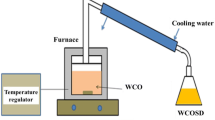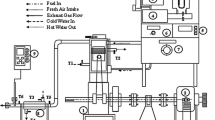Abstract
The depleting of fossil fuel reserves and increasing environmental concerns have continued to stimulate research into biodiesel as a greener fuel alternative produced from renewable resources. In this study, the performance and emission characteristics of biodiesel blends of 10, 30 and 50 % from waste cooking oil based on hydrodynamic cavitation were compared to diesel fuel, and found to be acceptable according to the EN 14214 and ASTM D 6751 standards. The tests have been performed using an in-line vertical six-cylinder diesel engine at different engine speeds, ranging from 1000 to 2000 rpm under full throttle load. During engine performance tests, biodiesel blends showed higher brake specific fuel consumption (2.1–9.0 %) and exhaust gas temperature (1.0–6.8 %), while lower brake power (1.6–6.7 %), torque (0.6–5.2 %) and brake thermal efficiency (1.9–8.4 %) than diesel fuel. Engine emissions showed higher carbon dioxide (8.7–38.5 %) and nitrogen oxide (4.7–19.0 %) releases, but surprisingly decreased amount of carbon monoxide (3.3–26.3 %) for biodiesel blends compared to diesel fuel. Although higher carbon dioxide amounts were emitted, the use of biodiesel greatly reduced the life cycle circulation of carbon dioxide. Waste cooking methyl ester produced by using hydrodynamic cavitation seems to be relatively easy to scale up to higher production values, is energy efficient, time saving and eco-friendly, which results in biodiesel being a viable fuel for industrial production. The waste cooking oil-based biodiesel can also be used without any engine modifications.










Similar content being viewed by others
References
Abbasi S, Diwekar UM (2014) Characterization and stochastic modeling of uncertainties in the biodiesel production. Clean Technol Environ Policy 16:79–94
Abedin MJ, Masjuki HH, Kalam MA, Sanjid A, Rahman SMA (2014) Performance, emissions, and heat losses of palm and jatropha biodiesel blends in a diesel engine. Ind Crop Prod 59:96–104
Ahmed S, Hassan MH, Kalam MA, Rahman SMA, Abedin MJ, Shahir A (2014) An experimental investigation of biodiesel production, characterization, engine performance, emission and noise of Brassica juncea methyl ester and its blends. J Clean Prod 79:74–81
Alptekin E, Canakci M (2008) Determination of the density and the viscosities of biodiesel-diesel fuel blends. Renew Energy 33:2623–2630
Altun S (2014) Effect of the degree of unsaturatin of biodiesel fuels on the exhaust emissions of a diesel power generator. Fuel 117:450–457
Altun S, Lapuerta M (2014) Properties and emission indicators of biodiesel fuels obtained from waste oils from the Turkish industry. Fuel 128:288–295
An H, Yang WM, Maghbouli A, Li J, Chou SK, Chua KJ (2013) Performance, combustion and emission characteristics of biodiesel derived from waste cooking oils. Appl Energy 112:493–499
Brondani M, Hoffmann R, Mayer FD, Kleinert JS (2014) Environment and energy analysis of biodiesel production in Rio Grande do Sul, Brazil. Clean Technol Environ Policy. doi:10.1007/s10098-014-0768-x
Bulatov I, Klemeš JJ (2011) Clean fuel technologies and clean and reliable energy: a summary. Clean Technol Environ Policy 13:543–546
Delavari A, Halek F, Amini M (2014) Continuous biodiesel production in a helicoidal reactor using ultrasound-assisted transesterification reaction of waste cooking oil. Clean Technol Environ Policy. doi:10.1007/s10098-014-0790-z
Elshaib AA, Kamal MM, Elahwany AA (2014) Performance of a diesel engine fueled by waste cooking oil biodiesel. J Energy Inst 87:11–17
Fernandes AMAP, Eberlin MN, Silva PRM, Silva SR, Cunha VS, Daroda RJ, Alberici RM (2014) Unsaturation levels in biodiesel via easy ambient sonic-spray ionization mass spectrometry. Fuel 128:99–103
Ghayal D, Pandit AB, Rathod VK (2013) Optimization of biodiesel production in a hydrodynamic cavitation reactor using used frying oil. Ultrason Sonochem 20:322–328
Ghobadian B, Rahimi H, Nikbakht AM, Najafi G, Yusaf TF (2009) Diesel engine performance and exhaust emission analysis using waste cooking biodiesel fuel with an artificial neutral network. Renew Energy 34:976–982
Gogate PR (2008) Cavitational reactors for process intensification of chemical processing applications: a critical review. Chem Eng Process 47:515–527
Halek F, Delavari A, Kavousi-rahim A (2013) Production of biodiesel as a renewable energy source from castor oil. Clean Technol Environ Policy 15:1063–1068
Ji J, Wang J, Li Y, Yu Y, Xu Z (2006) Preparation of biodiesel with the help of ultrasonic and hydrodynamic cavitation. Ultrasonics 44:411–414
Kalam MA, Masjuki HH, Jayed MH, Liaquat AM (2011) Emission and performance characteristics of an indirect ignition diesel engine fuelled with waste cooking oil. Energy 36:397–402
Klemeš JJ, Varbanov PS, Pierucci S, Huisingh D (2010) Minimising emission and energy wastage by improved industrial processes and integration of renewable energy. J Clean Prod 18:843–847
Lam HL, Varbonov P, Klemeš JJ (2010) Minimising carbon footprint of regional biomass supply chains. Resour Conserv Recycl 54:303–309
Lapuerta M, Armos O, Rodriguez-Fernandez J (2008) Effect of biodiesel fuels on diesel engine emissions. Prog Energy Combust Sci 34:198–223
Liaquat AM, Masjuki HH, Kalam MA, Rizwanul Fattah IM, Hazrat MA, Varman M, Mofijur M, Shahabuddin M (2013) Effect of coconut biodiesel blended fuels on engine performance and emission characteristics. Procedia Eng 56:583–590
Maddikeri GL, Pandidt AB, Gogate PR (2012) Intensification approaches for biodiesel synthesis from waste cooking oil: a review. Ind Eng Chem Res 51(45):14610–14628
Muralidharan K, Vasudevan D, Sheeba KN (2011) Performance, emission and combustion characteristics of biodiesel fuelled variable compression ratio engine. Energy 36:5385–5393
Nantha Gopal K, Pal A, Sharma S, Samanchi C, Sathyanarayanan K, Elango T (2014) Investigation of emission and combustion characteristics of a CI engine fueled with waste cooking oil methyl ester and diesel blends. Alex Eng J 53:281–287
O’Connell D, Savelski M, Stewart Slater C (2013) Life cycle assessment of dewatering routes for algae derived biodiesel processes. Clean Technol Environ Policy 15:567–577
Ong HC, Masjuki HH, Mahlia TMI, Silitonga AS, Chong WT (2014) Engine performance and emissions using Jatropha curcas, Ceiba pentandra and Calophyllum inophyllum biodiesel in a CI diesel engine. Energy 69:427–445
Ozener O, Yuksek L, Ergenc AT, Ozkan M (2014) Effect of soybean biodiesel on a DI diesel engine performance, emission and combustion characteristic. Fuel 115:875–883
Pal A, Verma A, Kachhwaha SS, Maji S (2010) Biodiesel production through hydrodynamic cavitation and performance testing. Renew Energy 35:619–624
Paul A, Bose PK, Panua R, Debroy D (2015) Study of performance and emission characteristics of a single cylinder CI engine using diethyl ether and ethanol blends. J Energy Inst 88(1):1–10
Petkovšek M, Zupanc M, Dular M, Kosjek T, Heath E, Kompare B, Širok B (2013) Rotation generator of hydrodynamic cavitation for water treatment. Sep Purif Technol 118:415–423
Pleanjal S, Gheewala SH, Garivait S (2009) Greenhouse gas emissions from production of use of used cooking oil methyl ester as transport fuel in Thailand. J Clean Prod 17:873–876
Qiu Z, Zhao L, Weatherley L (2010) Process intensification technologies in continuous biodiesel production. Chem Eng Process 49:323–330
Ramos MJ, Fernandez CM, Casas A, Rodriguez L, Perez A (2009) Influence of fatty acid composition of raw materials on biodiesel properties. Bioresour Technol 100:261–268
Resitoglu IA, Altinisik K, Keskin A (2014) The pollutant emissions from diesel-engine vehicles and exhaust aftertreatment systems. Clean Technol Environ Policy. doi:10.1007/s10098-014-0793-9
Rizwanul Fattah IM, Hassan MH, Kalam MA, Atabani AE, Abedin MJ (2014) Synthetic phenolic antioxidants to biodiesel: path toward NO x reduction of an unmodified indirect injection diesel engine. J Clean Prod 79:82–90
Sanjid A, Masjuki HH, Kalam MA, Ashrafur Rahman SM, Abedin MJ, Palash SM (2013) Impact of palm, mustard, waste cooking oil and Calophyllum inophyllum biofuels on performance and emission of CI engine. Renew Sustain Energy Rev 27:664–682
Sanjid A, Masjuki HH, Kalam MA, Ashrafur Rahman SM, Abedin MJ, Palash SM (2014) Production of palm and jatropha based biodiesel and investigation of palm-jatropha combined blend properties, performance, exhaust emission and noise in an unmodified diesel engine. J Clean Prod 65:295–303
Shuit SH, Lee KT, Kamaruddin AH, Yusup S (2010) Reactive extraction and in situ esterification of Jatropha curcas L. seeds for the production of biodiesel. Fuel 89:527–530
Singh D, Ganesh A, Mahajani S (2014) Heterogeneous catalysis for biodiesel synthesis and valorization of glycerol. Clean Technol Environ Policy. doi:10.1007/s10098-014-0858-9
Sun J, Caton JA, Jacobs TL (2010) Oxides of nitrogen emissions from biodiesel-fuelled diesel engines. Prog Energy Combust Sci 36:677–695
Suslick KS (1990) The chemical effects of ultrasound. Science 247:1439–1445
Tan K, Lee K, Mohamed A (2011) Potential of waste palm cooking oil for catalyst-free biodiesel production. Energy 36:2085–2088
Tan PQ, Zhao JY, Hu ZY, Lou DM, Du AM (2013) Effect of fuel properties on exhaust emissions from diesel engines. J Fuel Chem Technol 41(3):347–355
Tuccar G, Tosun E, Ozgur T, Aydin K (2014) Diesel engine emissions and performance from blends of citrus sinensis biodiesel and diesel fuel. Fuel 132:7–11
Wang LB, Yu HY, He XH, Liu RY (2012) Influence of fatty acid composition of woody biodiesel plants on the fuel properties. J Fuel Chem Technol 40(4):397–404
Wendy Ng PQ, Lam HL, Varbanov PS, Klemeš JJ (2014) Waste-to-energy (WTE) network synthesis for municipal solid waste (MSW). Energy Convers Manage 85:866–874
Xue JL, Grift TE, Hansen AC (2011) Effect of biodiesel on engine performances and emissions. Renew Sustain Energy Rev 15:1098–1116
Acknowledgments
The authors would like to thank the Universiti Teknologi PETRONAS for the Tuition Fee Assistantship (TFA) Scheme, Public Service Department of Malaysia, Marine Department Malaysia, MyRA for their financial support (Project No. 0153AB-J19), Green Energy – Higher Education Sector Specific Cooperation to Improve Rural Economy in the Field of Energetics and the Hungarian State and the European Union under project TAMOP-4.2.2.A-11/1/KONV-2012-0072 Design and optimisation of the modernisation and efficient operation of energy-supply and the utilisation systems using renewable energy sources and ICTs.
Author information
Authors and Affiliations
Corresponding author
Rights and permissions
About this article
Cite this article
Chuah, L.F., Aziz, A.R.A., Yusup, S. et al. Performance and emission of diesel engine fuelled by waste cooking oil methyl ester derived from palm olein using hydrodynamic cavitation. Clean Techn Environ Policy 17, 2229–2241 (2015). https://doi.org/10.1007/s10098-015-0957-2
Received:
Accepted:
Published:
Issue Date:
DOI: https://doi.org/10.1007/s10098-015-0957-2




